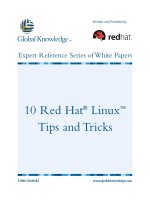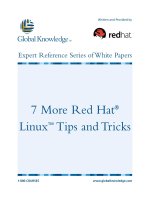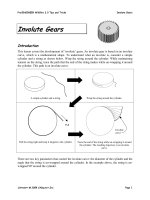Force.com Tips and Tricks pptx
Bạn đang xem bản rút gọn của tài liệu. Xem và tải ngay bản đầy đủ của tài liệu tại đây (3.59 MB, 225 trang )
www.it-ebooks.info
Force.com Tips and Tricks
A quick reference guide for administrators and
developers to get more productive with Force.com
Ankit Arora
Abhinav Gupta
BIRMINGHAM - MUMBAI
www.it-ebooks.info
Force.com Tips and Tricks
Copyright © 2013 Packt Publishing
All rights reserved. No part of this book may be reproduced, stored in a retrieval
system, or transmitted in any form or by any means, without the prior written
permission of the publisher, except in the case of brief quotations embedded in
critical articles or reviews.
Every effort has been made in the preparation of this book to ensure the accuracy
of the information presented. However, the information contained in this book is
sold without warranty, either express or implied. Neither the authors, nor Packt
Publishing, and its dealers and distributors will be held liable for any damages
caused or alleged to be caused directly or indirectly by this book.
Packt Publishing has endeavored to provide trademark information about all of the
companies and products mentioned in this book by the appropriate use of capitals.
However, Packt Publishing cannot guarantee the accuracy of this information.
First published: February 2013
Production Reference: 1230113
Published by Packt Publishing Ltd.
Livery Place
35 Livery Street
Birmingham B3 2PB, UK.
ISBN 978-1-84968-474-3
www.packtpub.com
Cover Image by Artie Ng ()
www.it-ebooks.info
Credits
Authors
Ankit Arora
Abhinav Gupta
Reviewers
Naveen Gabrani
Srikanth Goati
Aruna A. Lambat
Caleb Poitevien
Karanraj Sankaranarayanan
Dianne Siebold
Acquisition Editor
Rukhsana Khambatta
Lead Technical Editor
Dayan Hyames
Technical Editor
Prasad Dalvi
Project Coordinator
Leena Purkait
Proofreaders
Aaron Nash
Maria Gould
Indexer
Monica Ajmera Mehta
Graphics
Valentina D'silva
Production Coordinators
Melwyn D'sa
Nilesh R. Mohite
Cover Work
Melwyn D'sa
Nilesh R. Mohite
www.it-ebooks.info
About the Authors
Ankit Arora (@forceguru) is an avid Force.com-certied professional who
has been working on the platform since 2008. Since then, he has been involved in
architecting, building, and implementing Force.com solutions for on-premise and
AppExchange applications. He has also won many online challenges rolled out by
Salesforce such as TwitterTrivia, Hammer of Thor, and CloudTrivia.
Ankit is a Force.com MVP (Most Valuable Professional) and leader of Jaipur
Salesforce Platform Developer Users Group. He has been contributing to the
Salesforce community in various ways and through various channels. He is
passionate about Force.com and exhibits this by actively blogging at
forceguru.
blogspot.in
. He is acting as moderator on the Salesforce Discussion Boards
and shares his knowledge and experience by providing effective and converging
solutions to developer queries. He has submitted many cookbook recipes that can be
found in the online Force.com Cookbook.
Ankit resides in Jaipur, also known as the pink city, located in Rajasthan, India, a
city that has been able to maintain its rich heritage from the times of Maharajas, yet
picking up the pace to emerge as a strong contender for one of the fastest growing
cities in India. Ankit lives with his family and likes to play rst person combat games
such as Counter Strike in his free time. He is an enthusiast sportsman and a national
level player in the online Counter Strike competition.
Though only my name appears on the cover of this book, a great
many people have contributed to its production. In particular, I
would like to thank my brother-in-law Ajay Deewan, for being my
greatest teacher, mentor, and for helping me throughout the book.
His patience and support helped me overcome many crisis situations
and nish this book.
Finally I would like to thank my family and friends for
supporting me.
www.it-ebooks.info
Abhinav Gupta is a solution architect and an expert cloud computing consultant.
He is a Force.com contributor and an avid blogger. He actively participates on Force.
com discussion boards, blogs about cloud computing, Salesforce.com, and open
source technologies at , and also contributes to various open
source projects.
Abhinav has specialized in both native Force.com app development and B2B/B2C
integrations with other platforms/APIs. His area of expertise is not only limited
to Force.com; he has also done quality work on other cloud platforms such as
developing JEE apps on Heroku, Amazon Web Services (EC2, BeanStalk, and so on),
and Google App Engine. He is a Force.com MVP with notable achievements that
include creating the Code Share project Tolerado, winning third place in the 2010
Salesforce Developer Challenge with his mobile location sharing application, and
frequently being mentioned in the Salesforce.com newsletter and blog.
Abhinav lives in India with his wife and three-year-old daughter, and enjoys reading
technology books and magazines and playing computer games.
Thanks to my wife for being supportive and compromising her time
and weekends to spare me for the book, my little daughter for all
the fun and naughtiness she spreads around, my mom and dad for
all the affection and care, and last but not least the Packt Publishing
team and editors for their patience and cooperation throughout the
book writing process.
www.it-ebooks.info
About the Reviewers
Naveen Gabrani is a Force.com architect and is founder of the Salesforce consulting
company Astrea IT Services. Astrea is a leader in providing Salesforce.com services.
Astrea has three products on AppExchange, Smart vCard, Astrea Clone, and Object
Hierarchy, which were envisioned by Naveen. Naveen has 20 years of experience in
the IT industry in various technical and management positions.
Srikanth Goati is a Salesforce-certied professional and co-founder of Salesforce
Hyderabad User Group. Currently, he is working as a Salesforce administrator with
Y-Axis Solutions Pvt Ltd, Hyderbad, AP, India.
Srikanth is an MCA Graduate from Hyderabad. He has acquired the Salesforce
Certications DEV401 and ADM201. He is one of the top three bloggers in the
Salesforce community. He has conducted Salesforce training sessions for more than
350 users in his company.
Overall, he has more than 2 years of experience in Salesforce.com development
and administrating. He has experience in the Sales cloud, Service cloud, Apex,
Visualforce, Database.com, Site.com, and Customer portal.
Internally in his company, he has written more than 50 training manuals on different
modules of Salesforce.com.
I wish to thank my parents Prakash and Nagamani and all family
members, friends, colleagues, for all the joy they bring into my life.
Thanks to my Salesforce community friends.
Thanks to the folks at Packt Publishing, the authors of this book,
and the many others who have provided help and inspiration
along the way.
www.it-ebooks.info
Aruna A. Lambat is an enthusiastic Technical Leader working on Salesforce.com
technology with a profound understanding of software design and development. She
is passionate about building better products and providing excellent services leading
to healthier customer satisfaction.
She has been working on the Salesforce.com platform since 2008. She entered into IT
in 2004 as a student. She completed her Master's Degree in Computer Applications
from the state Maharashtra, India. She has been working in the IT industry since
2007. She started her carrier as a Java developer and later shifted her focus to cloud
computing, specically in Salesforce.com. She is a Sun-certicated Java developer,
web component developer, and Salesforce-certied developer. She is a regular
contributor to the Salesforce developer community. She helped the author to cite the
example in the book, Force.com Developer Certication Handbook (DEV401).
Aruna works for HCL Technologies; it is primarily engaged in providing a
range of outsourcing services, business process outsourcing, and infrastructure
services. Aruna works as a Lead Consultant on Salesforce.com technology-based
customer services.
Aruna resides in Pune, the cultural capital of Maharashtra, also known for its
educational facilities and relative prosperity. She is from Nagpur, the orange city.
Her parents staying in the heart of the orange city. She completed her education in
this city and achieved success at different time points in her career with immense
support from her parents Mr and Mrs Anandrao Lambat. Aruna loves travelling for
nature visits, reading ction books, playing pool, and roaming with friends in her
free time.
Aruna can be contacted at:
• Gmail:
• LinkedIn: Aruna Lambat
• Twitter: @arunalambat
• Facebook: /aruna.lambat
My special thanks to Siddhesh Kabe for his help and providing me
the opportunity for a little contribution for his book, which in turn
provided me with the opportunity to work for further Salesforce
books from Packt Publishing.
www.it-ebooks.info
Karanraj Sankaranarayanan is a certied Salesforce.com developer and works
full time at Tiara Consulting Services (I) Pvt Ltd, Chennai, the Indian operations of
Tiara Consulting headquartered in California, USA. Karan holds a Bachelors Degree
in Engineering from Anna University with a specialization in Computer Science. He
is passionate about the Salesforce platform, an active member/contributor of the
Salesforce customer community/developer forum, and writes blogs. He is also the
leader of the Chennai Salesforce Developer user group based in Chennai, India. He
can be reached via Twitter (@karanrajs).
www.it-ebooks.info
www.PacktPub.com
Support les, eBooks, discount offers
and more
You might want to visit www.PacktPub.com for support les and downloads related to your book.
Did you know that Packt offers eBook versions of every book published, with PDF and ePub les
available? You can upgrade to the eBook version at www.PacktPub.com and as a print book
customer, you are entitled to a discount on the eBook copy. Get in touch with us at service@
packtpub.com for more details.
At www.PacktPub.com, you can also read a collection of free technical articles, sign up for a range
of free newsletters and receive exclusive discounts and offers on Packt books and eBooks.
Do you need instant solutions to your IT questions? PacktLib is Packt's online digital book library.
Here, you can access, read and search across Packt's entire library of books.
Why Subscribe?
• Fully searchable across every book published by Packt
• Copy and paste, print and bookmark content
• On demand and accessible via web browser
Free Access for Packt account holders
If you have an account with Packt at www.PacktPub.com, you can use this to access PacktLib
today and view nine entirely free books. Simply use your login credentials for immediate access.
Instant Updates on New Packt Books
Get notied! Find out when new books are published by following @PacktEnterprise on
Twitter, or the Packt Enterprise Facebook page.
www.it-ebooks.info
www.it-ebooks.info
Table of Contents
Preface 1
Chapter 1: Learning to Fly with Force.com 9
What is cloud computing? 9
Infrastructure as a service (IaaS) 11
Platform as a service (PaaS) 12
Software as a service (SaaS) 12
What is Force.com? 13
What empowers Force.com? 13
Multitenancy 13
Metadata 14
Understanding the Force.com stack 15
Infrastructure as a service 15
Database as a service 16
Integration as a service 16
Logic as a service 17
User interface as a service 17
Development as a service 18
Force.com AppExchange 18
Introduction to governor limits 18
Salesforce environments 19
Summary 21
Chapter 2: Admin Tools 23
Data Loader 23
When to use Data Loader 24
Strategy to import data 24
Identifying data sources 24
Data preparation 25
Testing the data import 25
Analyzing the test import 26
Final data import 26
Validating the import 26
www.it-ebooks.info
Table of Contents
[ ii ]
Using Data Loader for data export 27
Using Data Loader for uploading attachments 28
The Import wizard 28
When to use the Import wizard 29
Notes on data import 29
Undoing data import 30
Third-party tools for data integration 30
Force.com Integrated Development Environment (IDE) 32
IDE communication 33
Force.com perspective 33
Problems view 34
Execute Anonymous view 34
Apex Test Runner view 35
Schema explorer 35
Deployment 35
Force.com Migration Tool 36
AppExchange – cloud application marketplace 37
DupeCatcher – real-time deduplication 38
Milestones PM – project and task management 38
Salesforce CRM dashboards 39
Salesforce for Twitter and Facebook (v4) 39
Appirio Contact Sync for Salesforce and Google Apps 39
Ribbit for Salesforce 39
SnapShot Change And Release Management 39
Salesforce Adoption Dashboards (2011) 40
Survey Force 40
Draggin' Role 40
Find Nearby – Accounts, Contacts, Leads – Managed, PE/EE/UE/DE 40
AppExchange Dashboard Pack 40
Action Plans – v3 – Unmanaged – EE, UE, and DE 41
Project and Issue Management 41
CloudConverter for Force.com 41
Opportunity Planning Wall 41
Data Loader – Salesforce integration 41
Mass Edit + Mass Update + Mass Delete 42
Implementation Cloud – project management app 42
S-Docs – free document generator (PDF, Word, Excel) 42
CMSForce 2 42
FormFactory quotes and invoices 43
Chatter Usage Dashboards – Force.com Labs 43
FinancialForce Accounting for Salesforce 43
www.it-ebooks.info
Table of Contents
[ iii ]
Professional Services Automation – PSA for Salesforce 43
CVM Supplier Central Enterprise Edition 43
CVM Supplier Locator 44
Summary 44
Chapter 3: Making Best Use of Salesforce Objects 45
Understanding the eld types 46
Basic non-relational eld types 46
Relational eld types 47
Identity elds 48
System elds 48
The Name eld 48
Additional database features 49
Considerations for relationships 50
Types of objects 53
Standard objects 53
Account 53
Contact 54
Lead 55
Campaign 56
Opportunity 57
Forecast 58
Quote 58
Product and price book 59
Case 60
Custom objects 61
Design approach 61
Implementation steps 62
Tips 63
Record types 64
Summary 66
Chapter 4: Understanding Analytics 67
Report types 68
Tips and considerations for report types 69
Dening report types 69
Choosing object relationships 70
Adding lookup elds 70
Reports 71
Organizing reports 72
Working with reports 73
Creating reports 73
Subtotaling the report results 79
Running reports 82
Scheduling a report 83
Printing and exporting reports 84
www.it-ebooks.info
Table of Contents
[ iv ]
Report charts 85
Combination charts 85
Dynamic reports 86
Dashboards 86
Working with dashboards 88
Dashboard lters 92
Dashboard data refresh 92
Analytic snapshots 93
Tips for analytic snapshots 93
Tips on target objects 94
Summary 95
Chapter 5: Setting Up Development Environments 97
Building apps on Salesforce 98
What is an environment? 98
Production environment 99
Development environments 99
Sandbox orgs 99
Conguration-only sandbox 101
Developer sandbox 101
Full sandbox 102
Typical uses of sandboxes 102
Tips for creating or refreshing a sandbox 103
Developer Edition orgs 103
Individual versus partner DE 104
When to use individual DE org 104
When to use partner DE org 104
Tips and best practices 104
Choosing a development environment 104
Development considerations 105
Testing environments 105
When to use a Partner Test Edition org 106
When to use a sandbox org 106
Various development scenarios 106
Scenario 1 106
Scenario 2 107
Scenario 3 107
Migrating changes between environments 107
Migrating changes manually 108
Establishing a change process for production org 108
Tracking changes 109
Metadata migration 110
Migration using change sets 110
Migrating metadata les 111
www.it-ebooks.info
Table of Contents
[ v ]
Application lifecycle management 111
Production development 112
Developing with sandbox 112
Isolating development and testing 113
Multiple project development with integration, UAT, and staging 114
Developing enterprise applications 115
Summary 116
Chapter 6: Tools and Destinations that Every Force.com
Developer Should Know 117
Tools for developers and admins 118
Choosing the right IDE 118
Force.com IDE based on Eclipse 118
Developer console based on your browser 119
Sublime Text plugin for Force.com 120
Exploring objects, elds, and relationships using Schema Browsers 122
Schema Builder 122
Force.com Explorer 123
SoqlXplorer 123
Data Loaders 123
Data Loader for Windows 123
Force.com Excel Connector 124
LexiLoader for Mac OS 124
Utility tools and apps for productivity boost 125
Force.com migration tool 125
Salesforce Workbench 125
Force.com Security Code Scanner 126
Force.com Utility Belt 127
Trapdoor (Mac OS only) 128
Toolkits and libraries 129
Destinations 130
developer.force.com 130
Open source goodness 130
Queries and troubleshooting 131
Summary 132
Chapter 7: Writing Better Apex Code 133
Understanding the language basics 134
Using the correct nomenclature for code les 134
Language constructs 136
Finding what's different with static keywords 136
Simplifying the loops 137
Making constants better with enums 137
Reducing script statements 138
www.it-ebooks.info
Table of Contents
[ vi ]
Advanced Apex 138
Security data access via the with sharing keyword in classes 139
Enforcing CRUD and FLS 139
Writing better SOQL queries 140
Query-required elds only 140
Using SOQL for loops 141
Executing selective and index-based queries 142
Combining multiple SOQLs to avoid governor limits 142
Fixing SOQL that returns a single record 143
Making the most out of dynamic SOQL 144
Taking control on DML operations 145
Controlling transaction commits and rollbacks 145
Fine-tuning with extra DML options 146
Error handling during DML operations 147
Decoding the Apex Describe Information 148
Getting info about sObjects and associated elds 148
Accessing/updating the sObject records based on eld names 150
Getting SobjectType from ID 150
Instantiating classes dynamically 150
Writing better triggers 152
Understanding the order of execution for triggers 152
Writing triggers to handle bulk data 152
Multiple triggers on an sObject 153
Handling XML in Apex 154
Handling JSON in Apex 156
Packaging considerations with Apex 156
API version 157
Changing API versions 158
Apex testing tips 159
Isolating test data from org data 159
Testing with various proles 159
Letting your class know about the test context 160
Apex REST web services 160
API versioning with REST web services 160
Knowing the limits 161
Tracking resource (limit) usage 162
Summary 165
Chapter 8: Writing Better Visualforce Code 167
Knowing the Visualforce architecture 168
Reusing the platform's native look and feel 169
Starting the page design with native headers 169
Native detail sections/forms 170
Styling tables to look like native grids 171
Printing messages in a native style 172
www.it-ebooks.info
Table of Contents
[ vii ]
Native (standard) versus custom controllers/extensions 173
Reusing VF code 174
Including other VF pages 175
Dening templates or page layouts 175
Dening your own components 176
Limiting view states 176
Use the view state inspector 177
Using static when possible 177
Trimming the view state by using transient variables 178
Identifying a transient variable 178
Avoid multiple forms 179
Query-required elds only 180
More tips and tricks on the view state 181
Flexible pages using eld sets 181
Speeding up Ajax calls 182
Using the immediate attribute 182
Re-rendering required components only 182
Demarcating using action regions 183
Global variables and functions 183
JavaScript remoting 184
Public versus global – using the right access modier 184
Making the most out of the method arguments and return types 185
Handling namespace prexes in managed packages 185
Approach 1 185
Approach 2 186
Taking care of security compliance in pages 186
Encode/escape 186
Enforcing CRUD and FLS 187
Miscellaneous tips 189
Querying a million rows 189
Rendering a page as a PDF 190
Dynamic VF components 190
Charts 190
Summary 191
Index 193
www.it-ebooks.info
www.it-ebooks.info
Preface
Force.com is an interesting platform, which allows us to do many things by using the
declarative or point-and-click model; without writing a single line of code. This book
takes you beyond any documentation or course, and promises hands-on expertise.
Force.com Tips and Tricks will quickly groom you for various Force.com platform
secrets that can normally be learnt only after years of exposure. This book is your
key to the authors' vast experience with the platform.
Force.com Tips and Tricks starts with very basic admin tasks and gradually moves to
hardcore coding tips and tricks for the multitenant Force.com platform.
You will learn admin concepts and basics where you will gain tips and tricks for key
topics such as schema and accurate reporting for an organization. Troubleshooting
a problem and code re-use are two important aspects that help in boosting
productivity; a complete chapter is dedicated to these tasks. As the Force.com
platform is multitenant in nature, it requires a more mature mindset compared
to other programming languages; expert tips on developing this skill are covered
in detail.
What this book covers
Chapter 1, Learning to Fly with Force.com, covers the basics of cloud computing.
This chapter discusses the principles and constructs of Force.com, the benets and
building blocks of Force.com, when to choose this platform, and many more topics.
Chapter 2, Admin Tools, delves deeper into the Force.com platform. This chapter will
discuss topics such as Data Loader, the Import wizard, AppExchange marketplace,
and Integrated Development Environment.
www.it-ebooks.info
Preface
[ 2 ]
Chapter 3, Making Best Use of Salesforce Objects, discusses different eld data types in
Salesforce, various considerations for dening relationships between objects, key
standard objects (for CRM), and so on.
Chapter 4, Understanding Analytics, explains about the Salesforce analytics.
Salesforce.com provides a very comprehensive analytics and reporting system,
which can be used to organize, view, and analyze your data so as to provide
real-time visibility into the business.
Chapter 5, Setting Up Development Environments, discusses various development and
test environments, and their usages in different scenarios. This chapter will provide
tips on how to choose an appropriate development environment.
Chapter 6, Tools and Destinations that Every Force.com Developer Should Know,
introduces various tools such as Schema Explorers, toolkits, and data migrators,
and destinations such as Twitter, Cookbook, and the DeveloperForce wiki.
Chapter 7, Writing Better Apex Code, illustrates some key best practices, tips, and tricks
to write better code in Apex and maintain a good relationship with the governor,
that is, as a good tenant.
Chapter 8, Writing Better Visualforce Code, covers tips and tricks around key
Visualforce areas such as differentiating facts about Visualforce architecture,
how to re-use the native look and feel in pages, and limiting the view state.
What you need for this book
Here is the list of software that you may require for implementing the examples
discussed in this book:
• Stable version of a good A grade browser (latest version would be best)
supported by Salesforce, such as Chrome, Firefox, or Internet Explorer
• Salesforce Developer Edition Org—one you can sign up for an account at
/>php?d=70130000000EjHb
• Eclipse for desktop installation or an in-browser Developer Console should
be ne
• Salesforce DataLoader and Microsoft Excel for Data Loader related tasks
www.it-ebooks.info
Preface
[ 3 ]
Who this book is for
Force.com Tips and Tricks is not a bible or a complete reference for the Force.com
platform development. The time-saving tips and tricks make this book handy for
novices as well as experienced developers. This is basically for Force.com developers,
who want to extend their Force.com applications, using Flex, Apex, and Visualforce.
When to adopt cloud computing
For an organization, shifting the delivery model from traditional on-premise
development to the cloud is a great strategic step, and there are some key
considerations to it. Services offered by the cloud vendors may not be suitable for
a particular enterprise as the size of an organization is one of the major deciding
factors. An organization may need a service when it is in the initial stages, but may
need to drop it as it grows.
Consider the following points when deciding on adopting the cloud delivery model:
• The cloud is built to scale its services on demand. Assess whether your
demand is stable or changes widely. If it's more or less stable, you may not
need to go for extensive cloud services, otherwise the cloud is for you.
• Is the usage frequency of cloud services high? If yes, you may not need to
opt for the cloud's "pay-as-you-go" model.
• If your application is mission critical, and needs very strict SLAs
(service-level agreements) and almost full control over the infrastructure,
you may need to reconsider going for the cloud.
• Are you a start up? If yes, you may not need to invest upfront heavily in
infrastructure. the cloud's "pay-as-you-go" model ts easily here.
• Does your organization have a preferred technology and development
platform? If yes, vendor lock-in may be a potential issue as migrating from
one cloud service provider to another would be much more painstaking than
doing it in-house with on-premise software.
• How do you want show your expenses in the balance sheet? Cloud
computing model related expenses are being treated as operational
expenses and not capital expenses!
www.it-ebooks.info
Preface
[ 4 ]
When to adopt Force.com for your
project
If you have decided to go with the cloud computing way, you may want to consider
the option of using Force.com for your projects. We have listed some key guidelines
based on the features that the platform has to offer, to help you decide whether
Force.com is the right choice for you or not.
• Is your application data centric with storage and retrieval of structured data?
This is the core capability of the platform, and applications that are focused
on structured data are best suited for this platform.
• Is your application going to store and work with high data volume? Do you
have any data warehousing requirements or complex analytics? Force.com
may not be the right choice in this case as it's a simple transactional database,
limited to only a few million records per object/table.
• Does your application involve large binary content les, such as audio/
video, and other heavy marketing material content? The data size is costly
on Force.com, so you may either consider another platform or work in
conjunction with other cloud services such as Amazon S3 servers.
• Is your application built around designing congurable dynamic page
layouts, wizards, reports, dashboards? Force.com is for you then.
• Does your application address a complex business problem involving many
workows and approvals? Do you want non-technical people to manage and
maintain applications with the point and click operations? Force.com is the
right choice here.
• Do you need ne-grained security and sharing settings on your data?
Do you want to provide hierarchical data access to your users based on
the organizational roles? Custom solutions take a lot of time to build this
capability, which is natively offered by the platform through the point and
click operations.
• Will your application talk to other applications? Is there any third-party
integration needed? Force.com has native robust and extensive support for
web services integration, both inbound and outbound.
• Does your application involve e-mails, discussions, and collaborations with
Twitter-like functionalities? Features such as e-mail services and chatter are
presented as native offerings, thus making Force.com the right choice.
www.it-ebooks.info
Preface
[ 5 ]
Conventions
In this book, you will nd a number of styles of text that distinguish between
different kinds of information. Here are some examples of these styles, and an
explanation of their meaning.
Code words in text are shown as follows: "Within the
build.xml le, there are
named targets that process a series of commands when you run Ant with a
target name."
A block of code is set as follows:
IF(
AND(Payment_Due_Date__c < TODAY(),
ISPICKVAL(Payment_Status__c, "UNPAID")),
"PAYMENT OVERDUE",
null )
When we wish to draw your attention to a particular part of a code block, the
relevant lines or items are set in bold:
public with sharing class AccountExtension {
public Account[] init() {
// Apart from matching criteria, only those accounts visible to
current user will be returned
return [Select Id, Name from Account Where Name like '%corp'];
}
}
New terms and important words are shown in bold. Words that you see on the
screen, in menus or dialog boxes for example, appear in the text like this: "If your
object name is not displayed, click on Show all objects."
Warnings or important notes appear in a box like this.
Tips and tricks appear like this.
www.it-ebooks.info
Preface
[ 6 ]
Reader feedback
Feedback from our readers is always welcome. Let us know what you think about
this book—what you liked or may have disliked. Reader feedback is important for
us to develop titles that you really get the most out of.
To send us general feedback, simply send an e-mail to
,
and mention the book title via the subject of your message.
If there is a book that you need and would like to see us publish, please
send us a note in the SUGGEST A TITLE form on
www.packtpub.com or
If there is a topic that you have expertise in and you are interested in either writing
or contributing to a book, see our author guide on
www.packtpub.com/authors.
Customer support
Now that you are the proud owner of a Packt book, we have a number of things to
help you to get the most from your purchase.
Downloading the example code
You can download the example code les for all Packt books you have purchased
from your account at . If you purchased this book
elsewhere, you can visit and register to
have the les e-mailed directly to you.
Errata
Although we have taken every care to ensure the accuracy of our content, mistakes
do happen. If you nd a mistake in one of our books—maybe a mistake in the text or
the code—we would be grateful if you would report this to us. By doing so, you can
save other readers from frustration and help us improve subsequent versions of this
book. If you nd any errata, please report them by visiting ktpub.
com/support
, selecting your book, clicking on the errata submission form link, and
entering the details of your errata. Once your errata are veried, your submission
will be accepted and the errata will be uploaded on our website, or added to any list
of existing errata, under the Errata section of that title. Any existing errata can be
viewed by selecting your title from />www.it-ebooks.info









